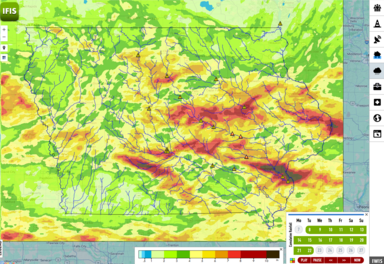How well does the short-term precipitation forecast support the National real-time streamflow forecasting system? This study, published in the Bulletin of the American Meteorological Society and led by researchers at IIHR—Hydroscience and Engineering and the Iowa Flood Center, addresses that question.
This work compares quantitative precipitation forecasts (QPF) with quantitative precipitation estimates (QPE) of observed rainfall. QPFs are advantageous over QPEs because they extend forecasting lead time, though this benefit can come at the cost of accuracy. Does the advantage of increased lead time in QPFs compensate for their reduced precision?

To investigate this question, three analyses were conducted. Collectively, they reveal that QPFs tend to be less accurate than the QPEs, especially for smaller drainage basins and longer forecast lead times.
Smaller drainage basins are particularly vulnerable to flash flooding, which is responsible for most flood-related deaths. Using accurate modeling for these basins is essential to reduce the risk of fatalities.
Although the QPFs often capture the correct rainfall amount, they frequently misplace where the precipitation occurs. This spatial error weakens the accuracy of streamflow simulations and limits the model’s ability to detect floods effectively, as it incorrectly locates the corresponding watershed.
The study shows that QPF reliability is limited, highlighting the need for continued improvement in rainfall forecasting.
This research strengthens both the National Water Model and Iowa's forecasting models, helping communities across the nation stay ahead of extreme weather and water hazards. By identifying where current systems fall short, this work creates opportunities for improvement.
